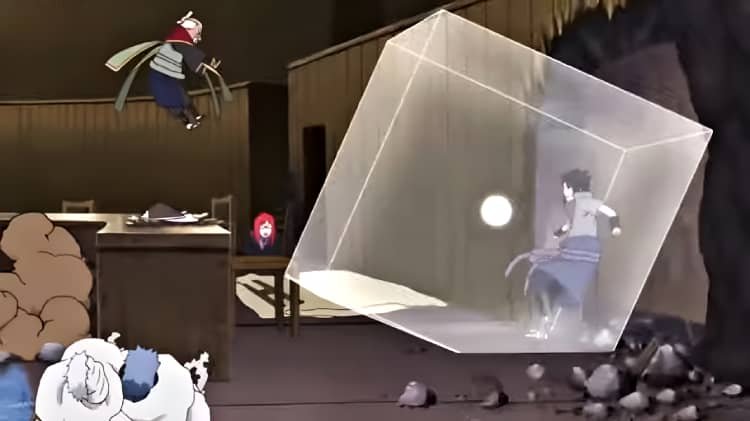For all the Naruto enthusiasts out there, one of the most unforgettable and impactful moments in the series occurs when Obito Uchiha intervenes to save Sasuke Uchiha from the devastating Jinton technique unleashed by Onoki, the Tsuchikage. Initially, it seemed that Sasuke was fated to meet his end at the hands of this powerful jutsu. However, Obito’s timely intervention altered the trajectory of the battle and allowed Sasuke to escape unscathed. This pivotal scene raises a compelling question: how exactly did Obito manage to save Sasuke? In this article, we will delve into the intricacies surrounding this moment to uncover the most plausible explanation for this significant event.
While some fans might speculate that Obito used his Kamui ability to transport Sasuke to another dimension, this theory is not entirely feasible. Obito himself has indicated that his Kamui, when utilized through one Sharingan, is rather slow. This was explicitly stated during a confrontation with Kakashi Hatake in the Fourth Great Ninja War. Therefore, if Kamui wasn’t the method Obito employed, what was it that enabled him to rescue Sasuke? Or did Masashi Kishimoto, the creator of Naruto, intentionally omit this information to ensure that Sasuke survived an encounter with Onoki?
Before we explore the possibilities, let’s consider a crucial moment from Obito’s past. During his battle against Konan, she set a deadly trap, aiming to end his life by utilizing all her chakra. Faced with no other options to escape, Obito resorted to his last resort: the Izanagi technique. This is how he managed to evade death and continue his journey.
Given this context, along with the fact that Obito had a hidden chamber filled with Sharingan, it becomes evident that Obito utilized Izanagi to save Sasuke from Onoki’s Jinton. If he had attempted to use Kamui, the speed would not have been sufficient to prevent Sasuke’s demise. At that moment, it was clear that Obito was not willing to gamble with Sasuke’s life, especially since he had a significant ally to protect.
For those still in doubt, it is indeed possible to use Izanagi to benefit others. This concept was explored in a filler episode of the anime, where an Izanagi user resurrects their companions. In Obito’s case, he could effectively wield Izanagi for others due to his mastery over both Uchiha and Senju powers.
In the broader context of Naruto, the significance of Obito’s actions cannot be overstated. His character arc evolves dramatically throughout the series, transitioning from a villain to a complex hero. This transformation is marked by moments like the one with Sasuke, where he chooses to protect others rather than pursue his selfish goals. Obito’s redemption arc is a central theme in Naruto, illustrating that even those who have strayed from their original path can find their way back through acts of kindness and sacrifice.
Furthermore, it’s important to highlight the relationship between Obito and Sasuke. Throughout the series, there are multiple layers to their connection. Obito sees echoes of his younger self in Sasuke, which compels him to intervene at critical moments. Sasuke, on the other hand, is portrayed as someone who has struggled with darkness and vengeance. Obito’s act of saving him signifies a shift—an opportunity for Sasuke to choose a different path, one that leads away from despair and towards hope.
The narrative intricacies in Naruto are a testament to Masashi Kishimoto’s storytelling prowess. Each character’s journey is interwoven with themes of loss, redemption, and the impact of choices. Obito’s decision to save Sasuke serves as a pivotal moment that influences not only Sasuke’s fate but also the broader outcome of the Fourth Great Ninja War. This act of heroism underlines the importance of alliances and the power of redemption, which are recurring motifs throughout the series.
Moreover, the use of Izanagi is significant in the context of the Uchiha clan’s lore. This forbidden technique allows the user to manipulate reality and evade death temporarily. The implications of using such a powerful jutsu raise ethical questions about its application and the consequences it brings. Obito’s use of Izanagi to save Sasuke serves as a reminder of the lengths individuals will go to for those they care about, even if it involves risking their own life and moral standing.
In conclusion, Obito’s intervention during that climactic moment not only altered the fate of Sasuke but also highlighted the complexity of his character. His evolution from a villain to a protector underscores the series’ overarching themes of redemption, sacrifice, and the intricate bonds between characters. The moment encapsulates the essence of Naruto, where battles are not just fought with strength but also with the heart.
As fans continue to analyze and discuss these pivotal moments in Naruto, it’s clear that the series provides a rich tapestry of character development and moral dilemmas. Obito’s choice to save Sasuke is a key example of how one act can resonate throughout the narrative, shaping the destinies of both characters and the world around them. The depth of these interactions ensures that Naruto remains a beloved and enduring story in the realm of anime and manga, captivating audiences with its timeless themes and unforgettable moments.
